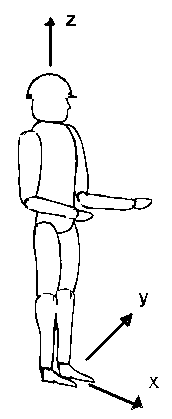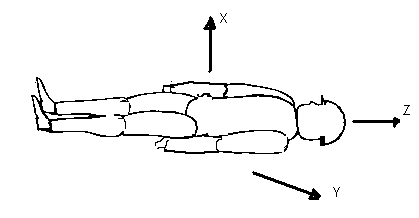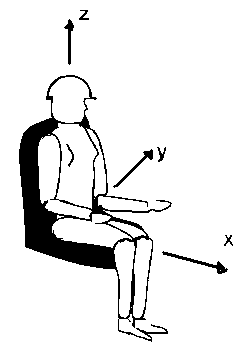Whole-Body Vibration Analysis Object (Human Body Vibrations Option)
This analysis object is used to analyze mechanical vibrations affecting the human body. Whole-body vibrations are caused by vibrations transmitted through the seat or the feet by workplace machines and vehicles. Exposure to high levels of whole-body vibration can present risks to health and safety. The risks are greatest when the vibration magnitudes are high, the exposure durations long, frequent, and regular, and the vibration includes severe shocks or jolts.
The results of the analysis object are used to evaluate the risks caused by vibration. The directives and standards include exposure limit values that can be compared to the assessed results. In this way you can determine whether safety measures for eliminating or reducing the effects of vibration are necessary.
Vibration Direction
The acceleration signals already calibrated are used as input signals. You can use the vibration direction to specify whether a signal measured in the X,Y or Z direction is analyzed or whether the signals measured in the X, Y and Z direction are to be pulled together to be included in the analysis.



Frequency Weighting
The first step in the analysis consists of weighting the frequencies of the acceleration signals. This can be done both in the time domain as well as in the frequency domain (e.g. weighting of third octave bands). In FlexPro, filtering takes place in the time domain. The frequency weightings available are: Wb, Wc, Wd, We, Wf, Wh, Wj, Wk and Wm. Using the frequency weightings depends on the position (sitting, recumbent, standing), site (feet, pelvis, head) and direction of measurement as well as the assessment type (health assessment, comfort/perception assessment).
Frequency Weighting |
Use |
ISO Standard |
|---|---|---|
unweighted |
|
|
Wb |
Vibrations in railway vehicles |
ISO 2631-4 |
Wc |
Vibrations when sitting with a backrest; direction of vibration X |
ISO 2631-1 |
Wd |
Horizontal vibrations when standing, seated and recumbent |
ISO 2631-1 |
We |
Rotational vibrations |
ISO 2631-1 |
Wf |
Evaluation of kinetosis (motion sickness) at frequencies below 0.5 Hz when seated and recumbent; direction of vibration Z |
ISO 2631-1 |
Wh |
Hand-transmitted vibration |
ISO 5349-1 |
Wj |
Vibrations when recumbent (head); direction of vibration X |
ISO 2631-1 |
Wk |
Vertical vibrations when standing, seated and recumbent |
ISO 2631-1 |
Wm |
Vibration in buildings |
ISO 2631-2 |
Evaluation Method, K-Factor
To make it easier for you to choose the right weighting filter, pre-defined evaluation methods are available in the analysis object that indicate which weighting filters and their corresponding k-factors are the right ones to use. The multiplying factors (k-factors) are required for calculating particular evaluation criteria (e.g., vibration total value). In addition, you have the option of manually setting the weighting filter and k-factor for each direction.
Output Options
The analysis object offers a variety of output options that can be used to evaluate the effects of vibration on the human body. Scalar values are used except for in the case of the frequency-weighted acceleration signal. Since the results are output as a list, you can use the List Element operator to access the individual elements.
The following output options are available for individual directions of vibration:
Option |
List Element Name |
Description |
|---|---|---|
Frequency-weighted acceleration signal |
.["FrequencyWeightedSignal_X"] |
The calibrated acceleration signal is filtered using one of the band-limited weighting filters described above. The input signal is output when using an unweighted filter. |
Frequency-weighted acceleration aw |
.["aw_X"] |
The square mean (RMS value) of the frequency-weighted acceleration signal provides the frequency-weighed acceleration aw. |
Peak of frequency-weighted acceleration signal |
.["Peak_X"] |
The maximum from the amount of the frequency-weighted acceleration signal. |
Crest factor |
.["CrestFactor_X"] |
Quotient from the peak value and the frequency-weighted acceleration aw. The frequency-weighted acceleration can be insufficient for the assessment for particular signals, such as signals with occasional shocks. If the crest factor is greater than 9, the maximum transient vibration value (MTVV) or the vibration dose value (VDV) should be studied instead of the frequency-weighted acceleration. |
Maximum Transient Vibration Value |
.["MTVV_X"] |
Maximum value of the floating RMS value. The floating RMS value can be affected by the integration time. |
Vibration Dose Value |
.["VDV_X"] |
The Vibration Dose Value (VDV) is the integral above power of four of the current vibrating motion. The advantage of this is that the individual peaks are more strongly emphasized than the RMS value. |
Estimated Vibration Dose Value |
.["eVDV_X"] |
The estimated vibration dose value using the frequency-weighted acceleration. |
Daily exposure VDVexp |
.["VDVexposure_X"] |
The value is used for assessing the daily exposure to vibrations based on the vibration dose value VDV. |
Daily exposure A(8) |
.["A8_X"] |
This refers to the equivalent continuous acceleration, normalized to an 8-hour day. The value is used for assessing the daily exposure to vibrations. |
Time until the exposure action value of A(8) is reached |
.["EAV_TIME_A8_X"] |
The time until the daily exposure A(8) reaches the exposure action value of 0.5 m/s2 . |
Time until the exposure limit value of A(8) is reached |
.["ELV_TIME_A8_X"] |
The time until the daily exposure A(8) reaches the exposure limit value of 1.15 m/s2 . |
MTVV / aw |
.["MTVV_Y"] |
If MTVV / aw exceeds the value 1.5, the MTVV value needs to be assessed. |
VDV / ( aw * T1/4 ) |
.["VDV_AW_T025_X"] |
If VDV / ( aw * T1/4 ) exceeds the value 1.75, the vibration dose value VDV needs to be assessed. |
Additionally, the following output options are available in case acceleration signals are present in the X, Y and Z directions:
Option |
List Element Name |
Description |
|---|---|---|
Vibration total value av (Maximum) |
.["av_max"] |
The maximum from the three determined frequency-weighted accelerations in the X, Y and Z direction multiplied by the corresponding multiplying factor (k-factor). |
Vibration total value av (vector sum) |
.["av_vectorsum"] |
The vector sum from the three determined frequency-weighted accelerations in the X, Y and Z direction, each weighted by a k-factor. According to ISO 2631-1, this value is used for the health assessment. Otherwise, the maximum is used. |
Maximum daily exposure VDVexp |
.["VDVexposure_max"] |
The maximum from the determined daily exposures VDVexp in the X, Y and Z direction. |
Maximum daily exposure A(8) |
.["A8_max"] |
Maximum from the determined daily exposures A(8) in the X, Y and Z direction. |
Integration Time, Exposure Duration
Information on the integration time for the floating mean is required for calculating the maximum transient vibration value MTVV. The exposure duration is used to calculate the daily exposure VDV and the daily exposure A(8).
Note:
If several partial measurements are used for calculating the daily exposure, the partial results can be calculated using the analysis object. At the end, an FPScript formula needs to be developed to calculate the total result from the partial results. The Analysis Wizard creates this formula automatically. Up to 5 signals can be calculated per direction, stating the respective exposure duration.
The exposure action value and exposure limit value used conform to Directive 2002/44/EC. The following values apply particularly for the frequency-weighted accelerations for a sitting or standing employee (X direction: Wd, k-factor 1.4; Y direction: Wd, k-factor 1.4; Z direction: Wk, k-factor 1). However, the daily exposure can be calculated for other settings as well using the analysis object. There is a risk of damage if the exposure action value is exceeded. It is the responsibility of the employer to ensure that the risks caused by whole-body vibrations are eliminated or reduced to a minimum. If the daily exposure limit value is exceeded, immediate measures are required and employment of workers is prohibited.
Observed Standards
Standard |
Description |
|---|---|
ISO 2631-1:1997 |
Mechanical vibration and shock - Evaluation of human exposure to whole-body vibration - Part 2: Vibration in buildings (1 Hz - 80 Hz) Mechanical vibration and shock - Evaluation of human exposure to whole-body vibration - Part 1: General requirements |
ISO 2631-2:2003 |
Mechanical vibration and shock - Evaluation of human exposure to whole-body vibration - Part 2: Vibration in buildings (1 Hz to 80 Hz) |
ISO 2631-4:2001 |
Mechanical vibration and shock - Evaluation of human exposure to whole-body vibration - Part 4: Guidelines for the evaluation of the effects of vibration and rotational motion on passenger and crew comfort on fixed-guideway transport systems |
ISO 5349-1:2001 |
Mechanical vibration - Measurement and evaluation of human exposure to hand-transmitted vibration - Part 1: General requirements |
Directive 2002/44/EC |
on the minimum health and safety requirements regarding the exposure of workers to the risks arising from physical agents (vibration) |
